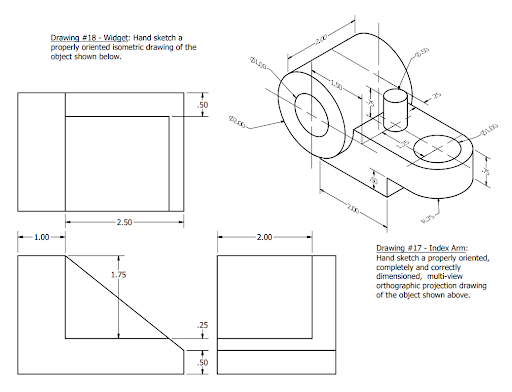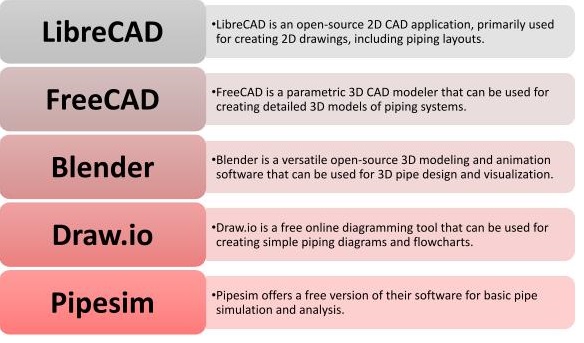Table of Content
- Isometric Drawings
- Need to transition from Physical Drawings to Pipeline Design Software
- Features and Functionality of Pipeline Isometric Drawings Software
- Best Piping Design Software
- Utilizing Pipeline Isometric Drawings Software for Different Applications
- Key Takeaways
In today's complex industrial landscape, the demand for efficient and accurate visualisation tools is ever-growing. By providing a detailed overview of pipeline isometric drawings software, readers will gain a better understanding of how this tool can streamline processes and improve project outcomes. Stay tuned to discover how this software can revolutionise the way engineering projects are planned and executed.
Pipeline isometric drawings are detailed representations of piping systems in three dimensions. They provide a clear visualisation of the layout, dimensions, and connections within a pipeline network. Understanding How to Read Isometric Drawings is essential for effective communication in engineering and design. To convey complex piping systems effectively, it's crucial to know How to Draw Isometric Drawings.
What are Isometric Drawings?
Isometric drawings are three-dimensional representations of objects, where all three axes are equally foreshortened to create a realistic image. These drawings are commonly used in engineering and construction to visualise pipelines and other structures in a detailed and accurate manner. Pipeline Isometric Drawings Software simplifies the creation and manipulation of these drawings, streamlining the design process for engineers and drafters.
Components of Pipeline Isometric Drawings
Pipeline isometric drawings typically include piping components such as pipes, fittings, valves, and instruments. They also incorporate annotations, dimensions, and symbols for clarity.
Purpose and Benefits of Pipeline Isometric Drawings
The primary purpose of pipeline isometric drawings is to provide a detailed visualisation of the piping system. They aid in accurate material take-offs, clash detection, and interference analysis, thereby enhancing project efficiency and reducing errors. Additionally, pipeline isometric drawings serve as a communication tool between engineers, drafters, and other stakeholders involved in the project. They help ensure that everyone has a clear understanding of the design and construction requirements.
Read More: Pipeline Isometric Drawings Explained: NDT Techniques & Interpretation
Why there is a need to transition from Physical Drawings to Pipeline Design Software?

Among the various types of pipeline drawings used in engineering, isometric drawings hold a special place. They provide a three-dimensional perspective that complements other types like Piping and Instrumentation Diagrams (P&ID), general arrangement drawings, and plan and profile drawings. Understanding the Types of Pipeline Drawings available is vital for choosing the right representation for a given project. The transition from physical piping drawings to pipeline design software includes a plethora of benefits, which include the following:
- Enhanced Precision:
Design software allows for superior precision compared to traditional physical drawings. Engineers can specify a wide range of measurements with utmost accuracy, including pipe diameters, lengths, angles, and clearances. This precision extends to components such as flange dimensions and weld joint specifications, ensuring that every detail is accurately represented.
- Improved Efficiency:
Generating digital Piping Drawings is notably quicker and more efficient than manual methods. Changes can be swiftly incorporated, and designs can be easily adjusted without starting from scratch.
- Simulation and Analysis:
Many design software tools include simulation and analysis features that offer the ability to model and evaluate a variety of conditions. Engineers can subject Piping Systems to diverse scenarios, such as Pressure, Temperature, Flow Rates, Stress Analysis, Fluid Properties, and Environmental Conditions.
- Seamless Collaboration:
Digital drawings can be conveniently shared and collaboratively worked on by geographically dispersed teams, streamlining communication and teamwork.
- Version Control:
Design software typically offers version control, allowing engineers to track changes and revert to previous iterations if necessary.
- 3D Modeling:
Numerous design software options enable 3D modeling of Piping Systems, offering a more comprehensive view of designs and helping to identify and address potential challenges.
- Automated Documentation:
The software can automatically generate detailed documentation, including bills of materials, saving time and ensuring accuracy in the design process.
- Integration with Manufacturing:
Digital Piping Drawings can be seamlessly integrated into manufacturing processes, minimizing errors during production.
- Efficient Archiving and Retrieval:
Digital drawings are easier to archive and retrieve, ensuring that vital design data remains accessible over time.
Features and Functionality of Pipeline Isometric Drawings Software
Pipeline isometric drawing software allows users to create detailed, accurate representations of piping systems in three dimensions. This software typically includes many features, here are a few listed below.
1. Automatic Piping Generation:
One of the standout features of pipeline isometric drawing software is its ability to automatically generate piping layouts based on input parameters. This significantly reduces manual effort and accelerates the design process.
2. Symbol Libraries:
These software solutions come equipped with extensive symbol libraries containing standard components such as pipes, fittings, valves, and instruments. Users can easily drag and drop these symbols onto their drawings, enhancing efficiency and consistency.
3. Annotation Tools:
Annotation tools enable users to add labels, notes, and dimensions to their drawings, providing clarity and context. This is essential for communicating design intent and specifications to stakeholders and contractors.
4. Dimensioning:
Accurate dimensioning is crucial in pipeline design to ensure proper fit and alignment of components. Pipeline isometric drawing software offers robust dimensioning tools that allow users to precisely define distances, angles, and sizes.
5. Compatibility with Industry Standards:
Leading software solutions adhere to industry standards such as ASME and ISO, ensuring compliance with regulatory requirements and interoperability with other systems.
6. Clash Detection:
Clash detection functionality helps identify potential conflicts or interferences between piping components, equipment, and structures. This early detection minimises costly errors and redesigns during the construction phase.
7. Pipe Stress Analysis:
Advanced software packages may include pipe stress analysis capabilities, allowing engineers to assess the structural integrity of piping systems under various operating conditions. This helps optimise design parameters and ensure compliance with safety standards.
8. Material Tracking:
Pipeline projects involve the use of various materials, each with its specifications and properties. Pipeline isometric drawing software enables users to track material information, including quantities, grades, and specifications, streamlining procurement and inventory management processes.
9. Integration with Other Software:
Seamless integration with other design and engineering software platforms such as CAD, BIM, and project management systems enhances workflow efficiency and data exchange across the project lifecycle.
10. Customisation Options:
These software solutions offer extensive customization options, allowing users to tailor the interface, workflows, and reports to their specific requirements. This flexibility ensures that the software aligns with the unique needs of each project and organisation.
What are the Best Piping Design Software?
Within the realm of piping design, the available software options offer a broad spectrum of capabilities to meet diverse needs. These isometric drawing tools can be categorized into two main types: free and paid. They cater to various requirements, ranging from fundamental 2D drafting to intricate 3D modeling and simulation.
1. Free Pipeline Design Software
Some commonly used Free Pipeline Design Software available include the following:

- LibreCAD:
LibreCAD is primarily used for 2D drafting and design and is not specifically focused on piping design, however, it is a valuable software to work with.
- FreeCAD:
FreeCAD is a versatile 3D CAD modeler that can be adapted for piping design but may require additional plugins or customization.
- Blender:
Blender is a 3D graphics software that is not specialized for piping design, but operators can adapt and utilize it for Pipeline Drawings.
- Draw. IO:
Draw.IO is a general-purpose diagramming tool and may not be suitable for detailed pipeline design, but is a useful free resource to create generalized Pipeline Drawings.
- Pipeism:
Pipeism is a specialized software for pipe stress analysis and design in engineering applications.
2. Paid Pipeline Design Software
Some commonly used Paid Pipeline Design Software available include the following:
- AutoCAD Plant 3D:
Autodesk's specialized piping design software for creating and managing 3D piping and instrumentation diagrams.
- AVEVA PDMS (Plant Design Management System):
A comprehensive 3D design solution for process plants, including piping systems.
- Intergraph SmartPlant 3D:
A powerful 3D design tool for the oil and gas industry, known for its piping design capabilities.
- CADWorx:
CADWorx is a specialized plant design software suite, including tools for piping and equipment design.
- Bentley AutoPIPE:
Bentley's software for pipe stress analysis and design.
- SolidWorks:
While primarily a 3D modeling tool, SolidWorks can be used for designing complex piping systems.
- SOLIDWORKS PDM (Product Data Management):
Manages design data, including piping-related information, for efficient collaboration.
- CATIA:
CATIA is a comprehensive 3D design and engineering software used in various industries, including piping design.
- Autodesk Revit:
Although known for building design, Revit can be used for MEP (Mechanical, Electrical, Plumbing) design, including piping.
- M4 PLANT:
A suite of plant design software tools for 3D modeling and documentation of piping systems.
- Smart® 3D:
A comprehensive 3D design and engineering software, particularly suitable for large and complex projects.
- PDMS:
A powerful 3D plant design tool developed by AVEVA for detailed piping design.
- AutoPLANT:
Bentley's plant design software suite, including tools for piping design.
- EdrawMax:
EdrawMax offers a range of diagramming tools, including those for creating piping diagrams.
- PROCAD Plant Design Suite:
A comprehensive suite of plant design software tools, including piping design capabilities.
- Lucidchart:
Lucidchart is a web-based diagramming tool that can be used for creating piping diagrams and flowcharts.
- SmartDraw:
SmartDraw is another diagramming tool suitable for creating piping diagrams and flowcharts.
The choice between free isometric drawing software and paid software hinges on the specific demands of projects and the available resources in question. Smaller projects with basic requirements might find free piping isometric drawing software sufficient, providing a cost-effective solution. However, for larger, more intricate projects that necessitate advanced modeling and simulation capabilities, investing in paid piping design software becomes a strategic choice.
Ultimately, the selection of software should align with your project's complexity, industry standards, and proficiency in handling the software tools, ensuring that you achieve the precision and efficiency required in the field of piping design.
Utilizing Pipeline Isometric Drawings Software for Different Applications
Pipeline Isometric Drawings Software serves as a versatile tool that finds application across various stages of pipeline projects. Let's explore how this software can be effectively utilised in different contexts:
1. Design and Engineering
In the design phase, the Isometric Pipe Drawing App enables engineers and designers to create detailed layouts of pipeline systems. By visualising the piping network in three dimensions, designers can optimise routing, spacing, and support structures to minimise material usage and construction costs. Additionally, the software facilitates collaboration among multidisciplinary teams, allowing seamless integration of mechanical, electrical, and structural components into the design.
2. Construction and Installation
During the construction phase, Pipeline Isometric Drawings Software plays a critical role in guiding contractors and installers through the assembly and installation process. Isometric drawings provide clear instructions on pipe routing, fitting connections, and equipment placement, ensuring accurate implementation of the design specifications. Moreover, the software's clash detection capabilities help identify potential conflicts with existing infrastructure or other trades, enabling preemptive resolution and minimising costly rework.
3. Maintenance and Asset Management
Post-construction, Pipeline Isometric Drawings Software becomes an invaluable asset for facility owners and operators in managing and maintaining their pipeline assets. The software facilitates the creation of comprehensive, as-built documentation, detailing the precise layout and configuration of the pipeline network. This information serves as a valuable reference for conducting inspections, troubleshooting issues, and planning maintenance activities.
Key Takeaways
- The transition from manual drafting to digital design methods, facilitated by the accessibility and user-friendliness of CAD software like AutoCAD, marked a profound transformation in engineering and design.
- The availability of both free pipe drawing software and paid pipeline design software offers professionals in the industry a wide range of options.
- The choice between these software types depends on project complexity and specific requirements, making it crucial for engineers and designers to select the right tools to meet the demands of their projects, ultimately defining the future of engineering and design.









